Automotive Software Market
Automotive Software Market Size and Share Forecast Outlook 2025 to 2035
Automotive software market is projected to grow from USD 28.5 billion in 2025 to USD 67.2 billion by 2035, at a CAGR of 9.0%. Infotainment Systems will dominate with a 34.0% market share, while passenger vehicles will lead the end use segment with a 64.0% share.
Automotive Software Market Forecast and Outlook 2025 to 2035
The automotive software market's trajectory from USD 28.5 billion in 2025 to USD 67.2 billion by 2035 represents substantial expansion, the market will rise at a CAGR of 9.0% which demonstrating accelerating adoption of connected vehicle technologies and growing investment in digital automotive solutions across manufacturing facilities, vehicle platforms, and mobility service operations worldwide.
The market operates within a dynamic landscape characterized by expanding software applications, vehicle electrification initiatives, and growing demand for intelligent vehicle systems across automotive manufacturing, autonomous driving development, connected services, and mobility platform applications. Market dynamics reflect increasing investment in software-defined vehicle architectures, accelerating adoption of cloud-based automotive services, and rising demand for integrated digital solutions that support diverse operational requirements and performance specifications.
Quick Stats for Automotive Software Market
- Automotive Software Market Value (2025): USD 28.5 billion
- Automotive Software Market Forecast Value (2035): USD 67.2 billion
- Automotive Software Market Forecast CAGR: 9.0%
- Leading Application in Automotive Software Market: Infotainment Systems
- Key Growth Regions in Automotive Software Market: Asia Pacific, North America, and Europe
- Key Players in Automotive Software Market: Microsoft, Google, Bosch, Continental AG
- Where revenue comes from - Now Vs Next (Industry-level view)
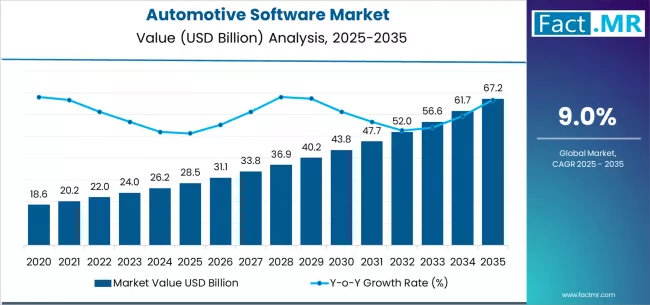
Vehicle development patterns demonstrate shifting preferences toward software-centric automotive systems that combine connectivity capabilities, autonomous functions, and user experience enhancement. Manufacturing facilities and automotive operators prioritize software scalability, integration compatibility, and operational reliability when selecting digital solutions for critical applications including infotainment systems, advanced driver assistance, vehicle management platforms, and fleet optimization.
The market benefits from expanding digitization activities across automotive manufacturing, mobility services, and vehicle technology sectors, driving demand for sophisticated software platforms that enable enhanced vehicle functionality and operational efficiency. Growing emphasis on connected mobility and autonomous capabilities creates opportunities for manufacturers offering validated software solutions with comprehensive integration expertise and performance assurance capabilities.
Technology advancement influences market evolution through integration of artificial intelligence applications, enhanced cloud connectivity, and advanced data processing capabilities that improve software performance and operational outcomes. Manufacturers focus on developing digital solutions that accommodate varying vehicle platforms, operating environments, and performance requirements while maintaining consistent functionality throughout extended service periods.
The automotive software market demonstrates strong growth fundamentals driven by expanding vehicle electrification, autonomous technology development, and increasing demand for connected vehicle solutions across multiple automotive sectors and operational applications.
The first half of the decade (2025-2030) will witness market growth from USD 28.5 billion to approximately USD 42.8 billion, adding USD 14.3 billion in value, representing 37% of the total forecast period expansion. This phase will be characterized by rapid adoption of connected vehicle technologies, driven by automotive digitization programs and increasing demand for advanced software capabilities across vehicle platforms.
The latter half (2030-2035) will experience accelerated growth from USD 42.8 billion to USD 67.2 billion, representing an addition of USD 24.4 billion or 63% of the decade's expansion. This period will be defined by mass market penetration of autonomous vehicle software, integration with smart mobility ecosystems, and seamless connectivity with existing transportation infrastructure.
The accelerated pace of innovation throughout this period will redefine how vehicles interact with their environment, infrastructure, and users. Strategic collaborations among automakers, software developers, and cloud service providers will drive continuous improvement in software reliability, cybersecurity, and over-the-air update capabilities, ensuring sustainable scalability and operational excellence across the evolving automotive ecosystem.
| Period | Primary Revenue Buckets | Share | Notes |
|---|---|---|---|
| Today | Infotainment systems | 34% | Entertainment, navigation, connectivity |
| Advanced driver assistance | 26% | Safety systems, collision avoidance | |
| Vehicle management | 18% | Engine control, transmission systems | |
| Connectivity services | 12% | Telematics, remote diagnostics | |
| Fleet management | 10% | Commercial vehicle operations | |
| Future (3-5 yrs) | Autonomous driving software | 28-32% | Self-driving capabilities, AI systems |
| Connected vehicle platforms | 22-26% | Cloud services, over-the-air updates | |
| Electric vehicle software | 18-22% | Battery management, charging systems | |
| Mobility-as-a-Service | 14-18% | Ride-sharing, vehicle sharing platforms | |
| Cybersecurity solutions | 8-12% | Vehicle security, data protection | |
| Specialized applications | 6-10% | Commercial vehicles, aftermarket solutions |
Automotive Software Market Key Takeaways
At-a-Glance Metrics
| Metric | Value |
|---|---|
| Market Value (2025) → | USD 28.5 billion |
| Market Forecast (2035) ↑ | USD 67.2 billion |
| Growth Rate ★ | 9.0% CAGR |
| Leading Application → | Infotainment Systems |
| Primary End-Use → | Passenger Vehicles |
The market demonstrates strong fundamentals with infotainment applications capturing dominant share through advanced connectivity capabilities and user experience optimization. Passenger vehicles drive primary demand, supported by increasing consumer expectations and vehicle digitization initiatives.
Geographic distribution remains concentrated in developed markets with established automotive infrastructure, while emerging economies show accelerating adoption rates driven by vehicle electrification programs and rising technology investment.
Imperatives for Stakeholders in Automotive Software Market
Design for integration excellence, not just functionality
- Offer complete software platforms: application development tools + cloud infrastructure + security protocols + update management + integration APIs + technical documentation.
- Preconfigured vehicle software stacks: operating systems, middleware platforms, application frameworks, and development environments for automotive operations.
Vehicle integration readiness
- Real-time performance monitoring, security management, and smart vehicle integration (connectivity platforms, data analytics systems).
Performance-by-design approach
- Advanced software development platforms, real-time system monitoring, performance validation, and comprehensive integration documentation.
Value-based pricing models
- Clear software platform pricing + transparent service tiers (development support, security services, performance guarantees); subscriptions for updates and technical support.
Segmental Analysis
The automotive software market demonstrates a diverse segmentation framework that reflects the industry’s rapid shift toward intelligent, connected, and digitally managed vehicle ecosystems. By application, the market encompasses infotainment systems, advanced driver assistance systems (ADAS), vehicle management software, connectivity platforms, fleet management solutions, and cybersecurity applications. This transition signifies a move from conventional mechanical control systems to sophisticated digital environments that enhance vehicle performance, user experience, and operational reliability through real-time analytics, predictive maintenance, and integrated communication technologies.
End-use segmentation highlights varying software integration requirements across passenger vehicles, commercial vehicles, electric vehicles, autonomous vehicles, and fleet operators. Each category demands unique system configurations and performance capabilities — from user interface customization in passenger vehicles to complex diagnostic and operational control systems in commercial and fleet environments. Electric and autonomous vehicles particularly drive innovation in energy management algorithms, AI-driven control modules, and safety monitoring systems.
From a technological standpoint, the market includes embedded software, cloud-based platforms, and mobile applications, indicating a growing emphasis on scalable, adaptive, and remotely updateable systems. Distribution channels extend across direct sales, automotive OEMs, and specialized software providers, enabling flexible partnerships and accelerated deployment of intelligent mobility solutions.
Market development spans North America, Latin America, Western and Eastern Europe, Asia Pacific, South Asia, and the Middle East & Africa. Mature markets such as the US, Germany, and Japan lead early adoption due to established automotive digitization frameworks, while emerging regions are witnessing accelerated growth through government-led electrification programs and expanding smart mobility infrastructure.
The segmentation underscores an industry in transformation, evolving from traditional automotive frameworks toward dynamic, multi-functional platforms that integrate connectivity, automation, and advanced data-driven intelligence.
How do Infotainment Systems maintain their Dominant Position in the Automotive Software Market?
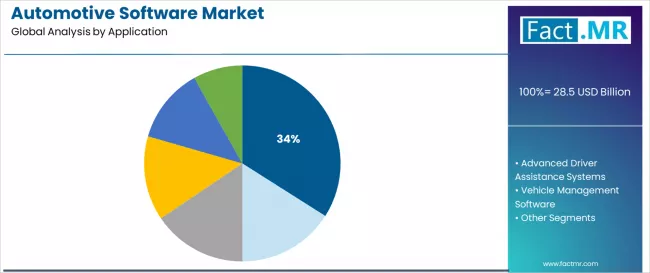
Infotainment systems hold the dominant position in the automotive software market, accounting for approximately 34% of the total market share. Their prominence stems from the widespread adoption of advanced digital entertainment and connectivity technologies that enhance user interaction and elevate in-vehicle experience.
These systems integrate seamlessly across various vehicle platforms, supporting audio, visual, and navigation functionalities while ensuring reliable connectivity between the driver, passengers, and external networks. The segment’s leadership reflects the growing consumer demand for immersive infotainment experiences and the automotive industry’s increasing focus on in-cabin digitization.
Growth is primarily driven by automakers’ preference for high-performance software solutions that provide consistent user engagement, robust reliability, and adaptable platform architecture without necessitating extensive hardware changes. Enhanced multimedia processing, voice recognition, cloud-based content access, and real-time system updates further strengthen its position as a core automotive software application.
These capabilities ensure smoother user interaction, precise operational control, and seamless integration with other vehicle systems such as navigation, safety monitoring, and connectivity modules. The infotainment systems segment also benefits from strong competitive differentiation through comprehensive software specifications, stable integration frameworks, and proven compatibility across diverse vehicle models.
These strengths enable manufacturers to maintain high standards of operational performance and user satisfaction, typically rated between 89% and 92% in system reliability and experience quality. The segment’s success is supported by advanced software architectures designed to optimize user experience, ensure seamless update management, and validate system performance, making infotainment systems the cornerstone of the modern connected vehicle ecosystem.
Why do Passenger Vehicles Dominate in the Automotive Software Industry?
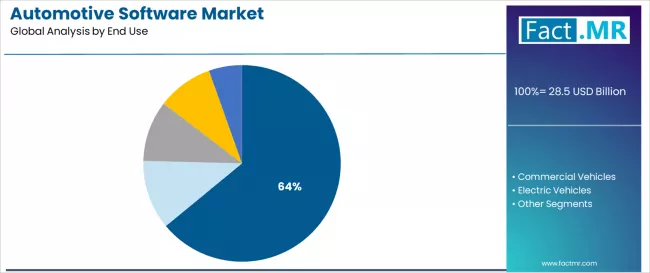
Passenger vehicles account for approximately 64% of the automotive software market, underscoring their position as the primary demand source for digital automotive technologies. This dominance reflects the expanding integration of software solutions in personal transportation, ranging from infotainment and navigation to safety, comfort, and connectivity systems.
As consumers increasingly expect seamless digital experiences within their vehicles, automakers are prioritizing software-defined architectures that enhance personalization, improve performance, and support continuous over-the-air updates. The segment’s scale and consumer-centric innovation make passenger vehicles a critical foundation for software adoption and standardization across the global automotive landscape.
Passenger vehicles enable scalable deployment models that optimize cost efficiency while maintaining consistent performance standards. Their widespread adoption of modular and interoperable software solutions allows manufacturers to reduce development time, simplify integration, and enhance user engagement across multiple vehicle classes.
The segment benefits from ongoing advancements in AI-assisted driving functions, cybersecurity frameworks, and connected mobility ecosystems, ensuring sustained growth and technological evolution. Passenger vehicles continue to drive market leadership by serving as the primary platform for introducing, testing, and scaling next-generation automotive software innovations.
What are the Drivers, Restraints, and Key Trends of the Automotive Software Market?
| Category | Factor | Impact | Why It Matters |
|---|---|---|---|
| Driver | Vehicle electrification & autonomous driving development (self-driving capabilities, battery management systems) | ★★★★★ | Growing electric vehicle market requires advanced software systems with enhanced battery optimization capabilities and autonomous features proven effective across vehicle applications. |
| Driver | Connected vehicle demand & mobility services (smart transportation, ride-sharing platforms) | ★★★★★ | Transforms software requirements from "basic vehicle control" to "intelligent mobility platform"; operators that offer advanced connectivity systems and service features gain competitive advantage. |
| Driver | Consumer technology expectations & digital experience (smartphone integration, voice control systems) | ★★★★☆ | Modern vehicle buyers need sophisticated, validated software systems; demand for intuitive and responsive digital solutions expanding addressable market. |
| Restraint | Cybersecurity concerns & data privacy regulations (especially for connected vehicles) | ★★★★☆ | Vehicle manufacturers defer software upgrades; increases security requirements and slows advanced technology adoption in privacy-conscious markets. |
| Restraint | Integration complexity & legacy system compatibility (traditional vehicle architectures, software standards) | ★★★☆☆ | Technical integration challenges limit software deployment options and increase development costs, potentially constraining adoption in conventional vehicle platforms. |
| Trend | Artificial intelligence integration & machine learning capabilities (predictive systems, personalization features) | ★★★★★ | Advanced software intelligence, performance optimization, and personalized user experiences transform operations; AI and machine learning become core value propositions. |
| Trend | Over-the-air updates & cloud-based services (remote software management, continuous improvement) | ★★★★☆ | Intelligent software management for specific applications and performance protocols; specialized update capabilities and targeted optimization drive competition toward cloud solutions. |
How Do Regional and Country-Level Trends Shape the Global Automotive Software Market Landscape?
The automotive software market reveals distinct regional growth patterns, shaped by varying levels of technological adoption, infrastructure maturity, and policy-driven innovation. Emerging economies such as China (10.4%) and India (9.8%) lead global expansion, fueled by rapid vehicle electrification, strong government support for digital transformation, and rising consumer demand for connected mobility solutions.
Steady performers like Germany (9.2%), Brazil (8.6%), and other industrially advanced regions are capitalizing on their established automotive ecosystems and expanding integration of connected vehicle technologies. Meanwhile, mature markets including the USA (8.1%), UK (7.5%), and Japan (6.9%) sustain consistent growth through continuous investments in advanced driver assistance systems (ADAS), autonomous vehicle software, and mobility-as-a-service (MaaS) platforms.
A broader regional synthesis highlights Asia Pacific as the frontrunner in automotive digitization and electric vehicle software development, while North America maintains steady advancement through autonomous driving innovations and software-defined vehicle architectures. Europe, on the other hand, exhibits robust momentum driven by connected mobility adoption, regulatory harmonization, and deep integration of software solutions across the automotive value chain.
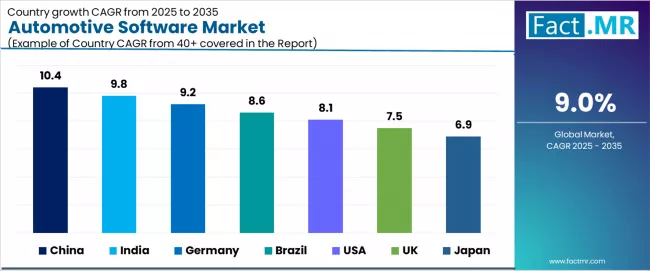
| Country | 2025-2035 Growth | How to win | What to watch out |
|---|---|---|---|
| China | 10.4% | Focus on electric vehicle software solutions | Regulatory changes; local competition |
| India | 9.8% | Lead with connectivity applications | Import restrictions; infrastructure barriers |
| Germany | 9.2% | Provide premium automotive platforms | Over-regulation; lengthy approvals |
| Brazil | 8.6% | Offer value-oriented solutions | Currency fluctuations; import duties |
| USA | 8.1% | Push autonomous driving technology | Compliance costs; scaling challenges |
| UK | 7.5% | Focus on mobility services | Economic impacts; funding constraints |
| Japan | 6.9% | Emphasize precision vehicle systems | Traditional preferences; adoption rates |
How Is China Accelerating Its Dominance in the Automotive Software Market?
China continues to lead the global automotive software market, registering the fastest CAGR of 10.4%, propelled by the government’s aggressive vehicle electrification policies and strong commitment to digital transformation across mobility ecosystems. The nation’s automotive landscape is being redefined by state-led initiatives that mandate the inclusion of intelligent software systems in EV manufacturing, battery management, and connected vehicle platforms. This framework not only fosters large-scale integration of automotive software but also promotes localization of development, making China the global epicenter for cost-efficient, scalable vehicle software deployment.
The integration of software-defined vehicle architectures has become central to China’s EV strategy, enabling advanced capabilities such as predictive maintenance, ADAS features, and seamless in-car connectivity. Automotive hubs like Beijing, Shanghai, and Shenzhen have become innovation corridors where OEMs collaborate with software developers to refine human-machine interfaces, optimize EV charging ecosystems, and enhance digital user experiences. These developments align with China’s broader industrial goals under its Made in China 2025 program, which emphasizes technological self-reliance in automotive intelligence.
Chinese manufacturers are also focusing on cost optimization and export potential, offering competitively priced yet technologically advanced automotive software solutions to emerging global markets. Strategic government subsidies for EVs and domestic R&D create a favorable environment for continuous innovation, ensuring China sustains its leadership in smart mobility technologies and embedded automotive intelligence.
Market Intelligence Brief:
- Government electric vehicle programs providing substantial funding for domestic automotive software development
- Export market development for cost-effective vehicle software solutions targeting emerging automotive markets
Why Is India Emerging as a High-Growth Market for Automotive Software?
India is rapidly becoming one of the fastest-expanding automotive software markets, achieving a 9.8% growth rate backed by accelerating digitalization and modernization across the vehicle manufacturing sector. The Indian government’s investments under initiatives such as Digital India and FAME-II (Faster Adoption and Manufacturing of Hybrid and Electric Vehicles) have strengthened the foundation for software-led automotive ecosystems. Urban centers like Mumbai, Delhi, and Bangalore are now witnessing the integration of connected vehicle systems as standard features, reflecting the country’s growing emphasis on safety, convenience, and performance optimization.
A key trend driving this expansion is the domestic adoption of intelligent mobility solutions, where software is increasingly being used to enhance navigation, fleet tracking, and predictive maintenance. Indian automotive OEMs are leveraging cloud-based applications and IoT-driven frameworks to elevate both passenger and commercial vehicle performance. These capabilities are particularly important in congested urban areas, where digital mobility solutions are addressing long-standing challenges related to traffic efficiency and vehicle management.
India’s rise in the global automotive software ecosystem also stems from strategic international collaborations. Partnerships between local manufacturers and global technology firms are accelerating access to advanced platforms such as over-the-air (OTA) updates, AI-enabled vehicle diagnostics, and real-time telematics integration. The result is a hybrid innovation model, one that combines cost-effective local production with world-class software capabilities.
Market Intelligence Brief:
- Automotive modernization programs emphasizing software systems for vehicle effectiveness and digital excellence
- Local manufacturers partnering with international providers for vehicle software development
- Automotive facilities implementing software systems for connectivity optimization and user experience management
How Does Germany Sustain Its Technological Leadership in Automotive Software?
Germany maintains its global reputation as a technology leader in the automotive software market, recording a 9.2% CAGR supported by deep-rooted engineering expertise and precision manufacturing excellence. The country’s automotive software ecosystem thrives on the strength of its well-established OEMs, Tier-1 suppliers, and R&D infrastructure, particularly across Bavaria, Baden-Württemberg, and North Rhine-Westphalia. German automotive manufacturers prioritize system integration and performance validation, ensuring that software systems align with EU compliance frameworks and stringent safety protocols.
One defining trend in Germany’s market development is the shift toward premium software-defined vehicle platforms. German brands are at the forefront of adopting advanced digital twins, vehicle OS architectures, and cybersecurity frameworks, ensuring vehicles not only meet but exceed international performance and safety benchmarks. Software platforms are increasingly being integrated into factory automation systems as well, enabling synchronized data exchange between production lines and vehicle diagnostics for enhanced operational accuracy.
Germany’s commitment to research collaboration and skill development continues to strengthen its software ecosystem. Joint initiatives between universities, automotive consortiums, and technology providers are promoting advancements in AI-driven driving systems and autonomous vehicle programming. As a result, Germany remains a model for balancing traditional automotive craftsmanship with cutting-edge digital innovation.
Market Intelligence Brief:
- Engineering focuses on EU standardization and precision compliance, driving premium segment growth
- Technology collaboration between German automotive companies and international software providers
- Professional training programs expanding software system integration in automotive scenarios
How Is Brazil Positioning Itself as a Regional Leader in Automotive Software?
Brazil’s automotive software market is expanding rapidly, anchored by the modernization of vehicle infrastructure and growing integration of digital systems in both passenger and commercial vehicles. With a growth rate of 8.6%, Brazil’s progress is underpinned by economic recovery, government initiatives promoting smart manufacturing, and increasing awareness of the advantages of software-driven vehicle operations. Automotive centers in São Paulo and Rio de Janeiro are spearheading the adoption of connected mobility solutions that enhance vehicle safety and operational control.
The country’s market trend focuses heavily on cost-effective and locally adaptable software solutions. Brazilian automotive operators prioritize affordability and practicality, leading to high demand for modular software systems that can be deployed across diverse vehicle categories. The localization of software production is gaining traction as companies explore partnerships with international firms to reduce import dependency while enhancing technical self-sufficiency.
Moreover, Brazil’s emphasis on sustainable automotive technologies aligns with software-enabled energy management, diagnostics, and emission control systems. As environmental regulations tighten, the integration of digital tools into production and vehicle management systems is transforming how Brazilian automakers balance efficiency with compliance, further reinforcing the market’s strong regional position.
Market Intelligence Brief:
- Automotive and passenger vehicle segments leading growth with focus on connectivity control and operational effectiveness applications
- Regional automotive requirements driving diverse product portfolio from basic software systems to premium solutions
- Import dependency challenges offset by potential local development partnerships with international manufacturers
- Government automotive initiatives beginning to influence procurement standards and software requirements
Why Does the USA Continue to Maintain Market Leadership in Automotive Software?
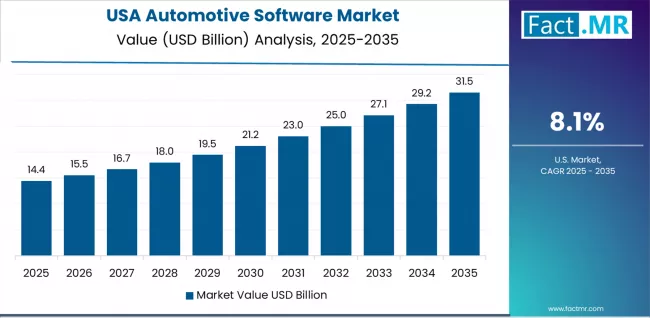
The USA remains a market leader in automotive software, reflecting its deep-rooted innovation culture and the maturity of its vehicle technology infrastructure. With an 8.1% growth rate, the country’s strength lies in its integrated automotive ecosystem encompassing traditional OEMs, EV startups, and autonomous driving technology developers. Regions like Michigan, California, and Texas have become global centers for automotive software advancement, driving progress in areas such as cloud-based connectivity, ADAS frameworks, and vehicle cybersecurity.
A significant trend shaping the USA market is the scaling of autonomous and software-defined vehicles (SDVs). American companies are leading global research on neural network-driven driving systems, vehicle OS design, and over-the-air (OTA) updates that continuously improve vehicle performance. The presence of established software giants collaborating with car manufacturers enables faster innovation cycles and robust platform integration across passenger and fleet mobility sectors.
In addition, the USA automotive market benefits from strong regulatory and institutional support. Policies promoting technology integration in safety and emission systems ensure consistent demand for automotive software. The ecosystem is further bolstered by advanced testing infrastructure, standardized interoperability frameworks, and skilled workforce development programs — collectively reinforcing the USA’s leadership in connected and autonomous vehicle innovation.
Market Intelligence Brief:
- Established regulatory standards providing consistent demand for vehicle technology advancement
- Technology integration programs expanding software capabilities in automotive scenarios
How Is the UK Advancing Premium Integration in Automotive Software?
The UK’s automotive software market demonstrates steady, quality-driven growth, achieving a 7.5% CAGR as automakers increasingly prioritize reliability, data integrity, and operational precision. The market benefits from a strong presence of high-value vehicle manufacturers across England, Scotland, and Wales, where digital software systems are now central to achieving production efficiency and vehicle innovation. The trend toward premium integration and system validation underscores the UK’s focus on software reliability and compliance with evolving EU and domestic standards.
A defining characteristic of the UK market is the collaborative nature of its software ecosystem. British automotive companies are forming strategic alliances with global technology providers to integrate connected mobility systems, telematics, and fleet optimization solutions. The focus extends beyond passenger vehicles to include public transport and logistics fleets, where software-driven optimization enhances safety, energy efficiency, and data transparency.
Moreover, the UK’s emphasis on training and technological upskilling ensures that its automotive workforce is well-equipped to manage software-intensive vehicle platforms. Through government-backed programs and private-sector investments, the country continues to develop new standards for software validation, cybersecurity, and autonomous driving, establishing itself as a reliable destination for premium automotive software integration.
Market Intelligence Brief:
- Automotive compatibility requirements driving standardized software system adoption
- Vehicle partnerships providing performance validation and effectiveness data
- Technology integration between UK automotive providers and international software companies
- Professional training programs expanding software system deployment in automotive scenarios
How Is Japan Advancing Precision in Automotive Software Development?
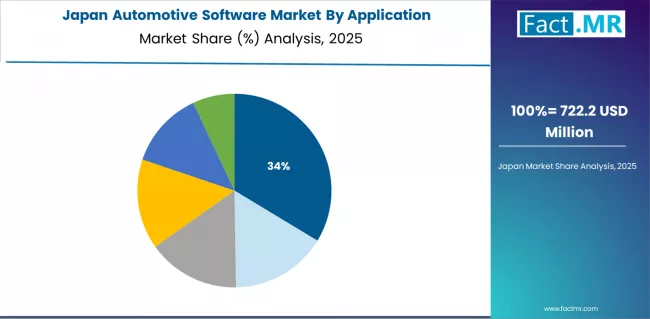
Japan’s automotive software market exemplifies precision-driven development, sustained by its culture of meticulous engineering and continuous improvement. The nation maintains a 6.9% growth rate, leveraging high-quality standards and advanced digital infrastructure to integrate sophisticated software solutions across automotive facilities in Tokyo, Osaka, and Nagoya. This precision-driven trend is visible in the adoption of AI-based quality control systems, autonomous driving algorithms, and next-generation infotainment frameworks that enhance vehicle intelligence and safety.
Japanese automakers are increasingly focusing on software-defined vehicle architectures, blending mechanical excellence with intelligent digital layers that enhance user experience and efficiency. Software applications are central to Japan’s push for automated mobility and hybrid-electric advancements, offering precise control over battery systems, navigation interfaces, and adaptive performance settings. These developments align with Japan’s national vision for carbon neutrality and transportation safety.
Furthermore, Japan’s strong emphasis on quality compliance and R&D partnerships enables it to sustain leadership in high-precision automotive systems. Collaborations between automakers, robotics firms, and software developers are resulting in new standards of efficiency and reliability — ensuring that Japanese automotive software continues to represent the global benchmark for accuracy, dependability, and advanced integration.
Market Intelligence Brief:
- Automotive and precision vehicle segments leading growth with focus on advanced software systems and quality applications
- Quality requirements driving premium product adoption from advanced vehicle software systems
- Technology integration challenges balanced by strong precision effectiveness and quality capabilities
- Automotive quality initiatives beginning to influence procurement standards and software requirements
What Defines Europe’s Collective Growth in the Automotive Software Market?
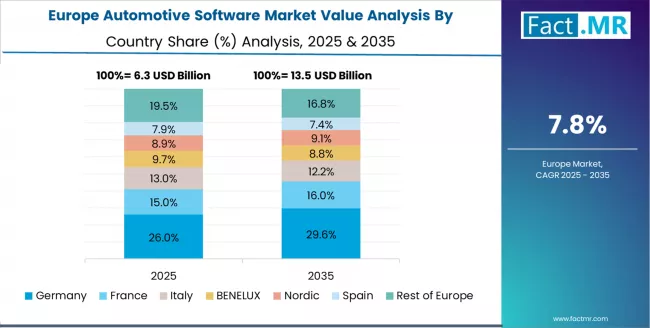
The European automotive software market is forecast to expand from USD 6.8 billion in 2025 to USD 13.2 billion by 2035, registering a 6.8% CAGR. Germany leads the regional market with a commanding 36.2% share, reflecting its dominance in engineering and vehicle digitization.
The UK follows with a 22.4% share, supported by strong mobility innovation programs and public–private sector collaboration. France maintains a 19.1% share, driven by specialization in compliance-oriented vehicle applications and safety software frameworks. Meanwhile, Italy (11.8%) and Spain (6.9%) continue to expand through growing adoption of smart mobility solutions and digital infrastructure upgrades. The rest of Europe, particularly the Nordic countries, is also witnessing momentum in EV software adoption and autonomous vehicle pilot projects, collectively advancing the region’s push toward intelligent, sustainable automotive systems.
Competitive Landscape of the Automotive Software Market
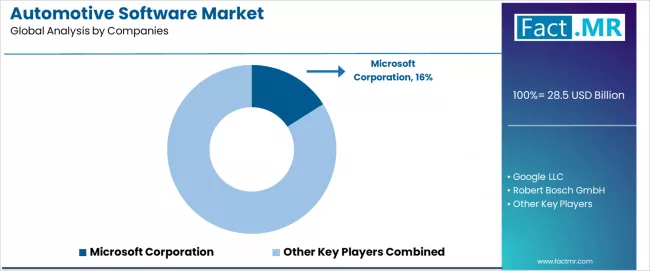
- Leading Company Share: Microsoft: 16% share
- Structure: ~18-22 credible players; top 5-7 hold ~52-58% by revenue.
- Leadership is maintained through: platform ecosystems, technology innovation, and product development (software performance + integration + user experience).
- What's commoditizing: basic software components and standard development tools.
- Margin Opportunities: custom platform services, system integration, and incorporation into vehicle workflows (development protocols, performance monitoring).
| Stakeholder | What they actually control | Typical strengths | Typical blind spots |
|---|---|---|---|
| Global technology platforms | Cloud infrastructure, development ecosystems, data analytics | Wide platform reach, proven scalability, multi-industry support | Vehicle-specific expertise; automotive compliance complexity |
| Automotive technology innovators | Vehicle software R&D; advanced autonomous systems; connected vehicle platforms | Latest automotive technologies first; attractive ROI on vehicle effectiveness | Service density outside core regions; scaling complexity |
| Regional automotive specialists | Local compliance, fast delivery, nearby automotive support | "Close to customer" automotive support; pragmatic pricing; local regulations | Technology gaps; talent retention in software development |
| Full-service providers | Complete software programs, system integration, performance monitoring | Lowest operational risk; comprehensive automotive support | Service costs if overpromised; technology obsolescence |
| Niche specialists | Specialized applications, custom development, technical services | Win premium applications; flexible configurations | Scalability limitations; narrow market focus |
Key Players in the Automotive Software Market
- Microsoft Corporation
- Google LLC
- Robert Bosch GmbH
- Continental AG
- Harman International Industries, Inc.
- NVIDIA Corporation
- Qualcomm Technologies, Inc.
- BlackBerry Limited
- Visteon Corporation
- Elektrobit Automotive GmbH
- Wind River Systems, Inc.
- Green Hills Software LLC
Scope of the Report
| Item | Value |
|---|---|
| Quantitative Units | USD 28.5 billion |
| Application | Infotainment Systems, Advanced Driver Assistance Systems, Vehicle Management Software, Connectivity Platforms, Fleet Management Solutions, Cybersecurity Applications |
| End Use | Passenger Vehicles, Commercial Vehicles, Electric Vehicles, Autonomous Vehicles, Fleet Operators |
| Regions Covered | North America, Latin America, Western Europe, Eastern Europe, Asia Pacific, South Asia, Middle East & Africa |
| Countries Covered | China, India, Germany, Brazil, USA, UK, Japan, Canada, France, Australia, and 25+ additional countries |
| Key Companies Profiled | Microsoft, Google, Bosch, Continental AG, Harman International, NVIDIA Corporation, Qualcomm Technologies |
| Additional Attributes | Dollar sales by application and end-use categories, regional adoption trends across Asia Pacific, North America, and Europe, competitive landscape with software developers and system integrators, automotive operator preferences for software effectiveness and performance control, integration with vehicle platforms and connectivity systems, innovations in automotive software technology and performance enhancement, and development of advanced digital solutions with enhanced functionality and operational optimization capabilities. |
Automotive Software Market by Segments
-
Application :
- Infotainment Systems
- Advanced Driver Assistance Systems
- Vehicle Management Software
- Connectivity Platforms
- Fleet Management Solutions
- Cybersecurity Applications
-
End Use :
- Passenger Vehicles
- Commercial Vehicles
- Electric Vehicles
- Autonomous Vehicles
- Fleet Operators
-
Technology :
- Embedded Software
- Cloud-Based Platforms
- Mobile Applications
-
Region :
- North America
- USA
- Canada
- Mexico
- Latin America
- Brazil
- Chile
- Rest of Latin America
- Western Europe
- Germany
- UK
- France
- Italy
- Spain
- Nordic
- BENELUX
- Rest of Western Europe
- Eastern Europe
- Russia
- Poland
- Rest of Eastern Europe
- Asia Pacific
- China
- Japan
- South Korea
- India
- Australia & New Zealand
- ASEAN
- Rest of Asia Pacific
- South Asia
- India
- Rest of South Asia
- Middle East & Africa
- Kingdom of Saudi Arabia
- Other GCC Countries
- Turkey
- South Africa
- Other African Union
- Rest of Middle East & Africa
- North America
Table of Content
- Executive Summary
- Global Market Outlook
- Demand to side Trends
- Supply to side Trends
- Technology Roadmap Analysis
- Analysis and Recommendations
- Market Overview
- Market Coverage / Taxonomy
- Market Definition / Scope / Limitations
- Market Background
- Market Dynamics
- Drivers
- Restraints
- Opportunity
- Trends
- Scenario Forecast
- Demand in Optimistic Scenario
- Demand in Likely Scenario
- Demand in Conservative Scenario
- Opportunity Map Analysis
- Product Life Cycle Analysis
- Supply Chain Analysis
- Investment Feasibility Matrix
- Value Chain Analysis
- PESTLE and Porter’s Analysis
- Regulatory Landscape
- Regional Parent Market Outlook
- Production and Consumption Statistics
- Import and Export Statistics
- Market Dynamics
- Global Market Analysis 2020 to 2024 and Forecast, 2025 to 2035
- Historical Market Size Value (USD Million) Analysis, 2020 to 2024
- Current and Future Market Size Value (USD Million) Projections, 2025 to 2035
- Y to o to Y Growth Trend Analysis
- Absolute $ Opportunity Analysis
- Global Market Pricing Analysis 2020 to 2024 and Forecast 2025 to 2035
- Global Market Analysis 2020 to 2024 and Forecast 2025 to 2035, By Application
- Introduction / Key Findings
- Historical Market Size Value (USD Million) Analysis By Application , 2020 to 2024
- Current and Future Market Size Value (USD Million) Analysis and Forecast By Application , 2025 to 2035
- Infotainment Systems
- Advanced Driver Assistance Systems
- Vehicle Management Software
- Connectivity Platforms
- Fleet Management Solutions
- Cybersecurity Applications
- Y to o to Y Growth Trend Analysis By Application , 2020 to 2024
- Absolute $ Opportunity Analysis By Application , 2025 to 2035
- Global Market Analysis 2020 to 2024 and Forecast 2025 to 2035, By End Use
- Introduction / Key Findings
- Historical Market Size Value (USD Million) Analysis By End Use, 2020 to 2024
- Current and Future Market Size Value (USD Million) Analysis and Forecast By End Use, 2025 to 2035
- Passenger Vehicles
- Commercial Vehicles
- Electric Vehicles
- Autonomous Vehicles
- Fleet Operators
- Y to o to Y Growth Trend Analysis By End Use, 2020 to 2024
- Absolute $ Opportunity Analysis By End Use, 2025 to 2035
- Global Market Analysis 2020 to 2024 and Forecast 2025 to 2035, By Region
- Introduction
- Historical Market Size Value (USD Million) Analysis By Region, 2020 to 2024
- Current Market Size Value (USD Million) Analysis and Forecast By Region, 2025 to 2035
- North America
- Latin America
- Western Europe
- Eastern Europe
- East Asia
- South Asia and Pacific
- Middle East & Africa
- Market Attractiveness Analysis By Region
- North America Market Analysis 2020 to 2024 and Forecast 2025 to 2035, By Country
- Historical Market Size Value (USD Million) Trend Analysis By Market Taxonomy, 2020 to 2024
- Market Size Value (USD Million) Forecast By Market Taxonomy, 2025 to 2035
- By Country
- USA
- Canada
- Mexico
- By Application
- By End Use
- By Country
- Market Attractiveness Analysis
- By Country
- By Application
- By End Use
- Key Takeaways
- Latin America Market Analysis 2020 to 2024 and Forecast 2025 to 2035, By Country
- Historical Market Size Value (USD Million) Trend Analysis By Market Taxonomy, 2020 to 2024
- Market Size Value (USD Million) Forecast By Market Taxonomy, 2025 to 2035
- By Country
- Brazil
- Chile
- Rest of Latin America
- By Application
- By End Use
- By Country
- Market Attractiveness Analysis
- By Country
- By Application
- By End Use
- Key Takeaways
- Western Europe Market Analysis 2020 to 2024 and Forecast 2025 to 2035, By Country
- Historical Market Size Value (USD Million) Trend Analysis By Market Taxonomy, 2020 to 2024
- Market Size Value (USD Million) Forecast By Market Taxonomy, 2025 to 2035
- By Country
- Germany
- UK
- Italy
- Spain
- France
- Nordic
- BENELUX
- Rest of Western Europe
- By Application
- By End Use
- By Country
- Market Attractiveness Analysis
- By Country
- By Application
- By End Use
- Key Takeaways
- Eastern Europe Market Analysis 2020 to 2024 and Forecast 2025 to 2035, By Country
- Historical Market Size Value (USD Million) Trend Analysis By Market Taxonomy, 2020 to 2024
- Market Size Value (USD Million) Forecast By Market Taxonomy, 2025 to 2035
- By Country
- Russia
- Poland
- Hungary
- Balkan & Baltic
- Rest of Eastern Europe
- By Application
- By End Use
- By Country
- Market Attractiveness Analysis
- By Country
- By Application
- By End Use
- Key Takeaways
- East Asia Market Analysis 2020 to 2024 and Forecast 2025 to 2035, By Country
- Historical Market Size Value (USD Million) Trend Analysis By Market Taxonomy, 2020 to 2024
- Market Size Value (USD Million) Forecast By Market Taxonomy, 2025 to 2035
- By Country
- China
- Japan
- South Korea
- By Application
- By End Use
- By Country
- Market Attractiveness Analysis
- By Country
- By Application
- By End Use
- Key Takeaways
- South Asia and Pacific Market Analysis 2020 to 2024 and Forecast 2025 to 2035, By Country
- Historical Market Size Value (USD Million) Trend Analysis By Market Taxonomy, 2020 to 2024
- Market Size Value (USD Million) Forecast By Market Taxonomy, 2025 to 2035
- By Country
- India
- ASEAN
- Australia & New Zealand
- Rest of South Asia and Pacific
- By Application
- By End Use
- By Country
- Market Attractiveness Analysis
- By Country
- By Application
- By End Use
- Key Takeaways
- Middle East & Africa Market Analysis 2020 to 2024 and Forecast 2025 to 2035, By Country
- Historical Market Size Value (USD Million) Trend Analysis By Market Taxonomy, 2020 to 2024
- Market Size Value (USD Million) Forecast By Market Taxonomy, 2025 to 2035
- By Country
- Kingdom of Saudi Arabia
- Other GCC Countries
- Turkiye
- South Africa
- Other African Union
- Rest of Middle East & Africa
- By Application
- By End Use
- By Country
- Market Attractiveness Analysis
- By Country
- By Application
- By End Use
- Key Takeaways
- Key Countries Market Analysis
- USA
- Pricing Analysis
- Market Share Analysis, 2024
- By Application
- By End Use
- Canada
- Pricing Analysis
- Market Share Analysis, 2024
- By Application
- By End Use
- Mexico
- Pricing Analysis
- Market Share Analysis, 2024
- By Application
- By End Use
- Brazil
- Pricing Analysis
- Market Share Analysis, 2024
- By Application
- By End Use
- Chile
- Pricing Analysis
- Market Share Analysis, 2024
- By Application
- By End Use
- Germany
- Pricing Analysis
- Market Share Analysis, 2024
- By Application
- By End Use
- UK
- Pricing Analysis
- Market Share Analysis, 2024
- By Application
- By End Use
- Italy
- Pricing Analysis
- Market Share Analysis, 2024
- By Application
- By End Use
- Spain
- Pricing Analysis
- Market Share Analysis, 2024
- By Application
- By End Use
- France
- Pricing Analysis
- Market Share Analysis, 2024
- By Application
- By End Use
- India
- Pricing Analysis
- Market Share Analysis, 2024
- By Application
- By End Use
- ASEAN
- Pricing Analysis
- Market Share Analysis, 2024
- By Application
- By End Use
- Australia & New Zealand
- Pricing Analysis
- Market Share Analysis, 2024
- By Application
- By End Use
- China
- Pricing Analysis
- Market Share Analysis, 2024
- By Application
- By End Use
- Japan
- Pricing Analysis
- Market Share Analysis, 2024
- By Application
- By End Use
- South Korea
- Pricing Analysis
- Market Share Analysis, 2024
- By Application
- By End Use
- Russia
- Pricing Analysis
- Market Share Analysis, 2024
- By Application
- By End Use
- Poland
- Pricing Analysis
- Market Share Analysis, 2024
- By Application
- By End Use
- Hungary
- Pricing Analysis
- Market Share Analysis, 2024
- By Application
- By End Use
- Kingdom of Saudi Arabia
- Pricing Analysis
- Market Share Analysis, 2024
- By Application
- By End Use
- Turkiye
- Pricing Analysis
- Market Share Analysis, 2024
- By Application
- By End Use
- South Africa
- Pricing Analysis
- Market Share Analysis, 2024
- By Application
- By End Use
- USA
- Market Structure Analysis
- Competition Dashboard
- Competition Benchmarking
- Market Share Analysis of Top Players
- By Regional
- By Application
- By End Use
- Competition Analysis
- Competition Deep Dive
- Microsoft Corporation
- Overview
- Product Portfolio
- Profitability by Market Segments (Product/Age /Sales Channel/Region)
- Sales Footprint
- Strategy Overview
- Marketing Strategy
- Product Strategy
- Channel Strategy
- Google LLC
- Robert Bosch GmbH
- Continental AG
- Harman International Industries, Inc.
- NVIDIA Corporation
- Qualcomm Technologies, Inc.
- BlackBerry Limited
- Visteon Corporation
- Elektrobit Automotive GmbH
- Wind River Systems, Inc.
- Green Hills Software LLC
- Microsoft Corporation
- Competition Deep Dive
- Assumptions & Acronyms Used
- Research Methodology
List Of Table
- Table 1: Global Market Value (USD Million) Forecast by Region, 2020 to 2035
- Table 2: Global Market Value (USD Million) Forecast by Application , 2020 to 2035
- Table 3: Global Market Value (USD Million) Forecast by End Use, 2020 to 2035
- Table 4: North America Market Value (USD Million) Forecast by Country, 2020 to 2035
- Table 5: North America Market Value (USD Million) Forecast by Application , 2020 to 2035
- Table 6: North America Market Value (USD Million) Forecast by End Use, 2020 to 2035
- Table 7: Latin America Market Value (USD Million) Forecast by Country, 2020 to 2035
- Table 8: Latin America Market Value (USD Million) Forecast by Application , 2020 to 2035
- Table 9: Latin America Market Value (USD Million) Forecast by End Use, 2020 to 2035
- Table 10: Western Europe Market Value (USD Million) Forecast by Country, 2020 to 2035
- Table 11: Western Europe Market Value (USD Million) Forecast by Application , 2020 to 2035
- Table 12: Western Europe Market Value (USD Million) Forecast by End Use, 2020 to 2035
- Table 13: Eastern Europe Market Value (USD Million) Forecast by Country, 2020 to 2035
- Table 14: Eastern Europe Market Value (USD Million) Forecast by Application , 2020 to 2035
- Table 15: Eastern Europe Market Value (USD Million) Forecast by End Use, 2020 to 2035
- Table 16: East Asia Market Value (USD Million) Forecast by Country, 2020 to 2035
- Table 17: East Asia Market Value (USD Million) Forecast by Application , 2020 to 2035
- Table 18: East Asia Market Value (USD Million) Forecast by End Use, 2020 to 2035
- Table 19: South Asia and Pacific Market Value (USD Million) Forecast by Country, 2020 to 2035
- Table 20: South Asia and Pacific Market Value (USD Million) Forecast by Application , 2020 to 2035
- Table 21: South Asia and Pacific Market Value (USD Million) Forecast by End Use, 2020 to 2035
- Table 22: Middle East & Africa Market Value (USD Million) Forecast by Country, 2020 to 2035
- Table 23: Middle East & Africa Market Value (USD Million) Forecast by Application , 2020 to 2035
- Table 24: Middle East & Africa Market Value (USD Million) Forecast by End Use, 2020 to 2035
List Of Figures
- Figure 1: Global Market Pricing Analysis
- Figure 2: Global Market Value (USD Million) Forecast 2020-2035
- Figure 3: Global Market Value Share and BPS Analysis by Application , 2025 and 2035
- Figure 4: Global Market Y to o to Y Growth Comparison by Application , 2025-2035
- Figure 5: Global Market Attractiveness Analysis by Application
- Figure 6: Global Market Value Share and BPS Analysis by End Use, 2025 and 2035
- Figure 7: Global Market Y to o to Y Growth Comparison by End Use, 2025-2035
- Figure 8: Global Market Attractiveness Analysis by End Use
- Figure 9: Global Market Value (USD Million) Share and BPS Analysis by Region, 2025 and 2035
- Figure 10: Global Market Y to o to Y Growth Comparison by Region, 2025-2035
- Figure 11: Global Market Attractiveness Analysis by Region
- Figure 12: North America Market Incremental Dollar Opportunity, 2025-2035
- Figure 13: Latin America Market Incremental Dollar Opportunity, 2025-2035
- Figure 14: Western Europe Market Incremental Dollar Opportunity, 2025-2035
- Figure 15: Eastern Europe Market Incremental Dollar Opportunity, 2025-2035
- Figure 16: East Asia Market Incremental Dollar Opportunity, 2025-2035
- Figure 17: South Asia and Pacific Market Incremental Dollar Opportunity, 2025-2035
- Figure 18: Middle East & Africa Market Incremental Dollar Opportunity, 2025-2035
- Figure 19: North America Market Value Share and BPS Analysis by Country, 2025 and 2035
- Figure 20: North America Market Value Share and BPS Analysis by Application , 2025 and 2035
- Figure 21: North America Market Y to o to Y Growth Comparison by Application , 2025-2035
- Figure 22: North America Market Attractiveness Analysis by Application
- Figure 23: North America Market Value Share and BPS Analysis by End Use, 2025 and 2035
- Figure 24: North America Market Y to o to Y Growth Comparison by End Use, 2025-2035
- Figure 25: North America Market Attractiveness Analysis by End Use
- Figure 26: Latin America Market Value Share and BPS Analysis by Country, 2025 and 2035
- Figure 27: Latin America Market Value Share and BPS Analysis by Application , 2025 and 2035
- Figure 28: Latin America Market Y to o to Y Growth Comparison by Application , 2025-2035
- Figure 29: Latin America Market Attractiveness Analysis by Application
- Figure 30: Latin America Market Value Share and BPS Analysis by End Use, 2025 and 2035
- Figure 31: Latin America Market Y to o to Y Growth Comparison by End Use, 2025-2035
- Figure 32: Latin America Market Attractiveness Analysis by End Use
- Figure 33: Western Europe Market Value Share and BPS Analysis by Country, 2025 and 2035
- Figure 34: Western Europe Market Value Share and BPS Analysis by Application , 2025 and 2035
- Figure 35: Western Europe Market Y to o to Y Growth Comparison by Application , 2025-2035
- Figure 36: Western Europe Market Attractiveness Analysis by Application
- Figure 37: Western Europe Market Value Share and BPS Analysis by End Use, 2025 and 2035
- Figure 38: Western Europe Market Y to o to Y Growth Comparison by End Use, 2025-2035
- Figure 39: Western Europe Market Attractiveness Analysis by End Use
- Figure 40: Eastern Europe Market Value Share and BPS Analysis by Country, 2025 and 2035
- Figure 41: Eastern Europe Market Value Share and BPS Analysis by Application , 2025 and 2035
- Figure 42: Eastern Europe Market Y to o to Y Growth Comparison by Application , 2025-2035
- Figure 43: Eastern Europe Market Attractiveness Analysis by Application
- Figure 44: Eastern Europe Market Value Share and BPS Analysis by End Use, 2025 and 2035
- Figure 45: Eastern Europe Market Y to o to Y Growth Comparison by End Use, 2025-2035
- Figure 46: Eastern Europe Market Attractiveness Analysis by End Use
- Figure 47: East Asia Market Value Share and BPS Analysis by Country, 2025 and 2035
- Figure 48: East Asia Market Value Share and BPS Analysis by Application , 2025 and 2035
- Figure 49: East Asia Market Y to o to Y Growth Comparison by Application , 2025-2035
- Figure 50: East Asia Market Attractiveness Analysis by Application
- Figure 51: East Asia Market Value Share and BPS Analysis by End Use, 2025 and 2035
- Figure 52: East Asia Market Y to o to Y Growth Comparison by End Use, 2025-2035
- Figure 53: East Asia Market Attractiveness Analysis by End Use
- Figure 54: South Asia and Pacific Market Value Share and BPS Analysis by Country, 2025 and 2035
- Figure 55: South Asia and Pacific Market Value Share and BPS Analysis by Application , 2025 and 2035
- Figure 56: South Asia and Pacific Market Y to o to Y Growth Comparison by Application , 2025-2035
- Figure 57: South Asia and Pacific Market Attractiveness Analysis by Application
- Figure 58: South Asia and Pacific Market Value Share and BPS Analysis by End Use, 2025 and 2035
- Figure 59: South Asia and Pacific Market Y to o to Y Growth Comparison by End Use, 2025-2035
- Figure 60: South Asia and Pacific Market Attractiveness Analysis by End Use
- Figure 61: Middle East & Africa Market Value Share and BPS Analysis by Country, 2025 and 2035
- Figure 62: Middle East & Africa Market Value Share and BPS Analysis by Application , 2025 and 2035
- Figure 63: Middle East & Africa Market Y to o to Y Growth Comparison by Application , 2025-2035
- Figure 64: Middle East & Africa Market Attractiveness Analysis by Application
- Figure 65: Middle East & Africa Market Value Share and BPS Analysis by End Use, 2025 and 2035
- Figure 66: Middle East & Africa Market Y to o to Y Growth Comparison by End Use, 2025-2035
- Figure 67: Middle East & Africa Market Attractiveness Analysis by End Use
- Figure 68: Global Market - Tier Structure Analysis
- Figure 69: Global Market - Company Share Analysis
- FAQs -
How big is the automotive software market in 2025?
The global automotive software market is estimated to be valued at USD 28.5 billion in 2025.
What will be the size of automotive software market in 2035?
The market size for the automotive software market is projected to reach USD 67.2 billion by 2035.
How much will be the automotive software market growth between 2025 and 2035?
The automotive software market is expected to grow at a 9.0% CAGR between 2025 and 2035.
What are the key product types in the automotive software market?
The key product types in automotive software market are infotainment systems, advanced driver assistance systems, vehicle management software, connectivity platforms, fleet management solutions and cybersecurity applications.
Which end use segment to contribute significant share in the automotive software market in 2025?
In terms of end use, passenger vehicles segment to command 64.0% share in the automotive software market in 2025.